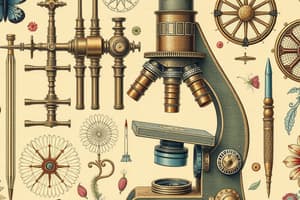Podcast
Questions and Answers
What is the primary function of the base of a microscope?
What is the primary function of the base of a microscope?
- Adjust the position of the stage
- Connect the eyepiece to the objective lenses
- Support the entire microscope (correct)
- Illuminate the specimen
Which part of the microscope is responsible for focusing light onto the specimen?
Which part of the microscope is responsible for focusing light onto the specimen?
- Illuminator
- Condenser (correct)
- Eyepiece
- Diaphragm
What is the purpose of the fine focus knob on a microscope?
What is the purpose of the fine focus knob on a microscope?
- To illuminate the specimen
- To support the entire microscope
- To precisely adjust the stage position (correct)
- To move the stage quickly for initial focus
What feature allows a user to switch between different objective lenses while maintaining focus?
What feature allows a user to switch between different objective lenses while maintaining focus?
Which part of the microscope connects the eyepiece to the objective lenses?
Which part of the microscope connects the eyepiece to the objective lenses?
Flashcards are hidden until you start studying
Study Notes
Microscope Parts
-
Base
- Supports the entire microscope.
- Provides stability.
-
Arm
- Connects the base to the head.
- Used for carrying the microscope.
-
Stage
- Platform where the slide is placed.
- May have clips to hold the slide in place.
-
Stage Controls
- Adjusts the position of the stage.
- Allows movement of the slide for viewing.
-
Illuminator
- Light source for illuminating the specimen.
- Can be built-in or external.
-
Condenser
- Focuses light onto the specimen.
- Improves image clarity.
-
Objective Lenses
- Multiple lenses with different magnifications (e.g., 4x, 10x, 40x, 100x).
- Located on the rotating nosepiece.
-
Eyepiece (Ocular Lens)
- Lens through which the viewer looks.
- Typically has a magnification of 10x or 15x.
-
Nosepiece
- Holds objective lenses.
- Allows the user to switch between different magnifications.
-
Fine Focus Knob
- Used for precise focusing.
- Adjusts the stage position in small increments.
-
Coarse Focus Knob
- Used to move the stage up or down quickly.
- Provides initial focus of the specimen.
-
Mechanical Stage
- Optional part that allows for precise movement of the slide.
- Often has controls for X and Y-axis movement.
-
Diaphragm
- Regulates the amount of light reaching the specimen.
- Enhances contrast.
-
Body Tube
- Connects the eyepiece to the objective lenses.
- Ensures proper alignment of the optical path.
-
Parfocal Capability
- Allows for maintaining focus when switching between objective lenses.
Understanding these parts and their functions is crucial for effectively using a microscope and obtaining clear observations of specimens.
Microscope Parts Overview
- Base: Provides stability and support for the entire microscope structure.
- Arm: Connects the base to the microscope head, serving as a handle for carrying.
- Stage: The platform for placing slides; often features clips to secure slides during observation.
- Stage Controls: Mechanism that adjusts the position of the stage to facilitate slide movement for better viewing angles.
- Illuminator: A light source essential for illuminating the specimen, available as built-in or external options.
- Condenser: Focuses and directs light onto the specimen, enhancing image clarity for improved visibility.
- Objective Lenses: Several lenses with varying magnifications (e.g., 4x, 10x, 40x, 100x) mounted on a rotating nosepiece for flexible viewing options.
- Eyepiece (Ocular Lens): The lens through which the viewer observes, typically magnifying by 10x or 15x.
- Nosepiece: Holds and allows rotation between objective lenses, enabling users to switch magnifications seamlessly.
- Fine Focus Knob: Facilitates precise adjustments for focus, allowing for fine-tuning of the specimen view.
- Coarse Focus Knob: Rapidly moves the stage up or down for initial focus adjustments before fine-tuning.
- Mechanical Stage: Optional feature providing accurate slide movement, often with X and Y-axis controls for enhanced maneuverability.
- Diaphragm: Controls the light amount reaching the specimen, improving contrast for clearer images.
- Body Tube: Connects the eyepiece and objective lenses, ensuring alignment of the optical path for optimal viewing.
- Parfocal Capability: Enables maintaining focus when switching between different objective lenses, facilitating continuous observation.
Importance of Understanding Parts
- Familiarity with these parts and their functions is essential for effective microscope use and achieving clear specimen observations.
Studying That Suits You
Use AI to generate personalized quizzes and flashcards to suit your learning preferences.




